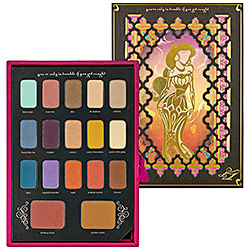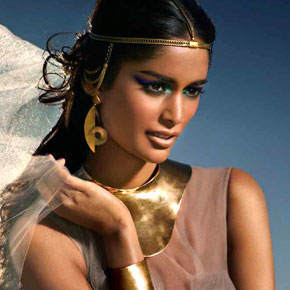For a myriad of complex reasons, my favourite Disney princess is undoubtedly Jasmine. I’ve talked here, here and here about the politics of her body, her ethnicity and her sexualized clothing in the larger context of Disney’s less-than-stellar record when it comes to race and representation. There’s no doubt that Disney’s princess of color are Othered both culturally and narratively: while Aurora, Snow White and Belle et al are protected and rescued by white knights who whisk them away to marriage and happiness, Mulan, Jasmine and most recently, Tiana, have much to overcome and struggle against before riding into the sunset with their heroes. Disney has yet to dismantle it’s narrative default of white, western femininity, and the massive revenues generated by Disney Princess merchandise is hardly an incentive to question their representational choices. So it was with no small degree of skepticism that I checked out Sephora’s Disney Princess-themed makeup collection, the second of which is designed after Jasmine.
Before offering an analysis I’ll first establish some context. Orientalism, as put forth by Edward Said, is the main framework through which I approach this topic. ‘Orientalism’ refers to stereotypes/fetishes/fantasies/misconceptions about the ‘Eastern’ world (particularly the Middle-east and Asia), created and sustained by British imperialism and in fact eventually becoming symbiotic with the expansion of the British empire. Orientalism reduces the vast heterogeneity of culture and heritage among the peoples of that region to commodifiable fantasies of submissive women, erotic harems and hedonistic pleasures. My previous posts on Jasmine delve deeper into the matter, but suffice it to say that Orientalism remains a persistent trend in Western media and culture.
The power of Orientalism lies in the interplay between revulsion and desire, where a dark and mysterious racial Other is equal parts titillating and terrifying. Certainly the charm of the alluring East is alive and well in the white imaginary, as cultural products like “Eat, Pray, Love”, “The Best Exotic Marigold Hotel” and “Memoirs of a Geisha” will testify. Orientalism offers both escape and pleasure, a chance to find oneself (the self, of course, being assumed white) and partake in ‘exotic’ cultures. Combined with current global power relations and a tourism industry geared towards white westerners, it’s easy to see how Orientalism continues to reinscribe imperialist ways of knowing and being.
Sephora’s Jasmine collection capitalizes on the embedded Orientalism of its source by invoking an imagery of escape and freedom and allure. The word ‘exotic’ features frequently, as do other connotative ones like “mystique”, “decadent” and “sultry”. The eyeshadow palette features colors with names that are as evocatively Orientalist as they are culturally vague: ‘sultana’, ‘bazaar’, ‘arabian sunset’ (what exactly is an ‘arabian sunset’? I’ve lived in Dubai for over 10 years yet I don’t believe I could describe the exact “arabian” nature of sunsets in the region). What does it mean for women of color like myself, and Arab women, to purchase makeup that’s described as ‘exotic’? Are women of color even considered a target demographic when products like the Jasmine line are marketed with such evocative imagery? And what does it mean for white consumers to purchase the Jasmine fantasy? In her article Unintentionally Eating the Other, Minh-ha T.Pham has this say about the commodification of Brown bodies and culture for white consumption:
allure. The word ‘exotic’ features frequently, as do other connotative ones like “mystique”, “decadent” and “sultry”. The eyeshadow palette features colors with names that are as evocatively Orientalist as they are culturally vague: ‘sultana’, ‘bazaar’, ‘arabian sunset’ (what exactly is an ‘arabian sunset’? I’ve lived in Dubai for over 10 years yet I don’t believe I could describe the exact “arabian” nature of sunsets in the region). What does it mean for women of color like myself, and Arab women, to purchase makeup that’s described as ‘exotic’? Are women of color even considered a target demographic when products like the Jasmine line are marketed with such evocative imagery? And what does it mean for white consumers to purchase the Jasmine fantasy? In her article Unintentionally Eating the Other, Minh-ha T.Pham has this say about the commodification of Brown bodies and culture for white consumption:
“This desire for transformation through the Other is not unique to fashion; it is connected to a much longer history of what Black feminist scholar bell hooks (always in lower case) calls “imperialist nostalgia”: the longing of whites to inhabit, if only for a time, the world of the Other. Bodily transcendence through sartorial and cosmetic play is enacted by the consumption of otherness – a “courageous consumption,” in hooks’ words – because it is about “conquering the fear [of racial difference] and acknowledging power. It is by eating the Other,” hooks explains, “that one asserts power and privilege.”
This issue of ‘consumption’ and transracial fantasy is further complicated when you add in that Jasmine’s concept design was based on a white woman, designer Mark Henn’s sister Beth Allen (pictured left). In an article on Jasmine’s concept trajectory, it’s noted that:
 ” Mark Henn who has been partially responsible for the design of every Disney princess since Ariel, turned to a number of exotic [emphasis mine] models to base Jasmine off of but ultimately was dissatisfied. He describes having seen a guest at Disney World with long black hair and knew he wanted that feature but was having difficulty finding a face for the princess. Eventually Henn looked in his wallet to find a high school graduation photo of his younger sister Beth Allen. He did a concept sketch based off of her which the directors liked and ended up approving.”
” Mark Henn who has been partially responsible for the design of every Disney princess since Ariel, turned to a number of exotic [emphasis mine] models to base Jasmine off of but ultimately was dissatisfied. He describes having seen a guest at Disney World with long black hair and knew he wanted that feature but was having difficulty finding a face for the princess. Eventually Henn looked in his wallet to find a high school graduation photo of his younger sister Beth Allen. He did a concept sketch based off of her which the directors liked and ended up approving.”
Actress Jasmine Guy (pictured right) was initially considered for the concept art, but her look was described as “too severe” by the designers and the Beth Allen design was used instead.
was described as “too severe” by the designers and the Beth Allen design was used instead.



